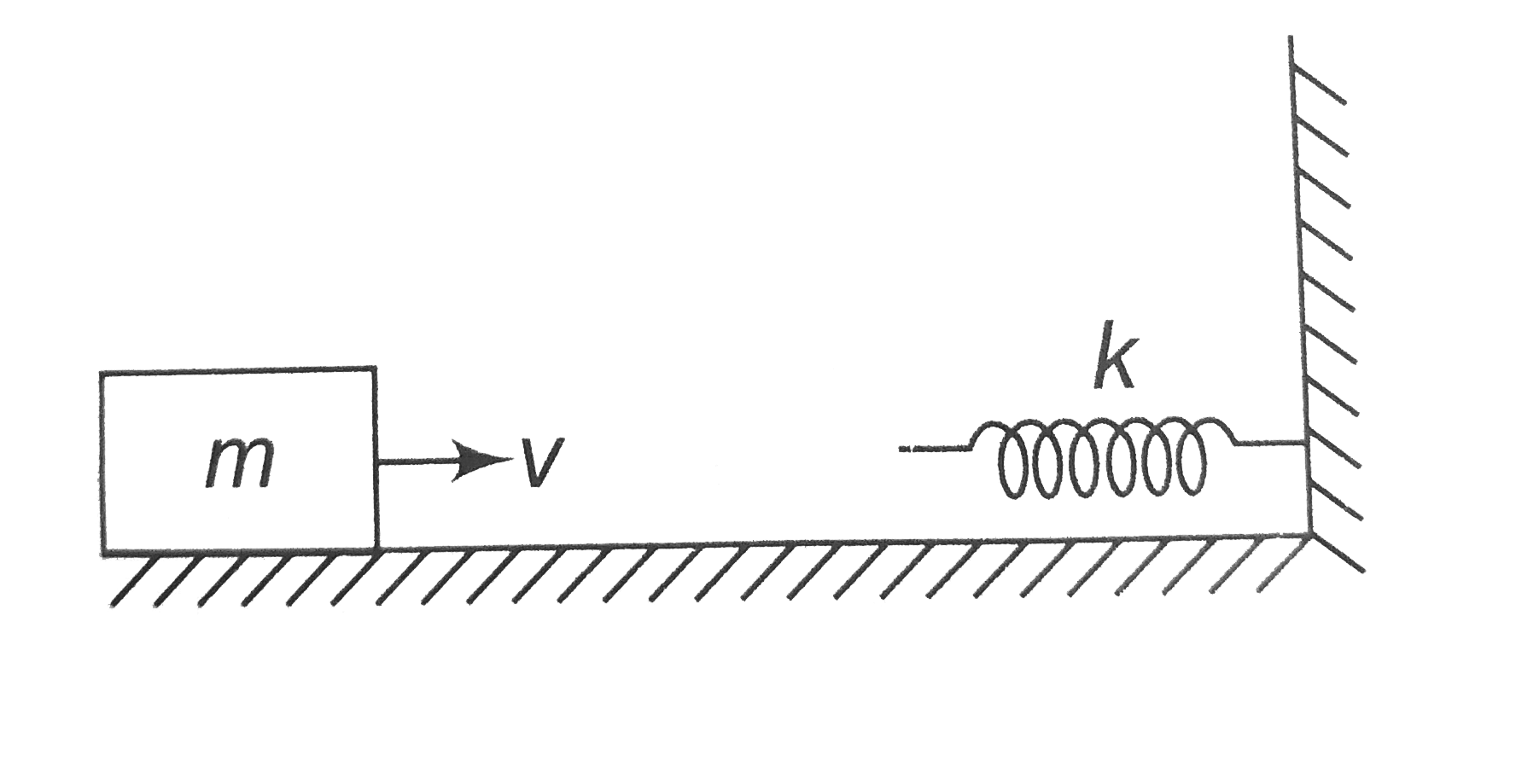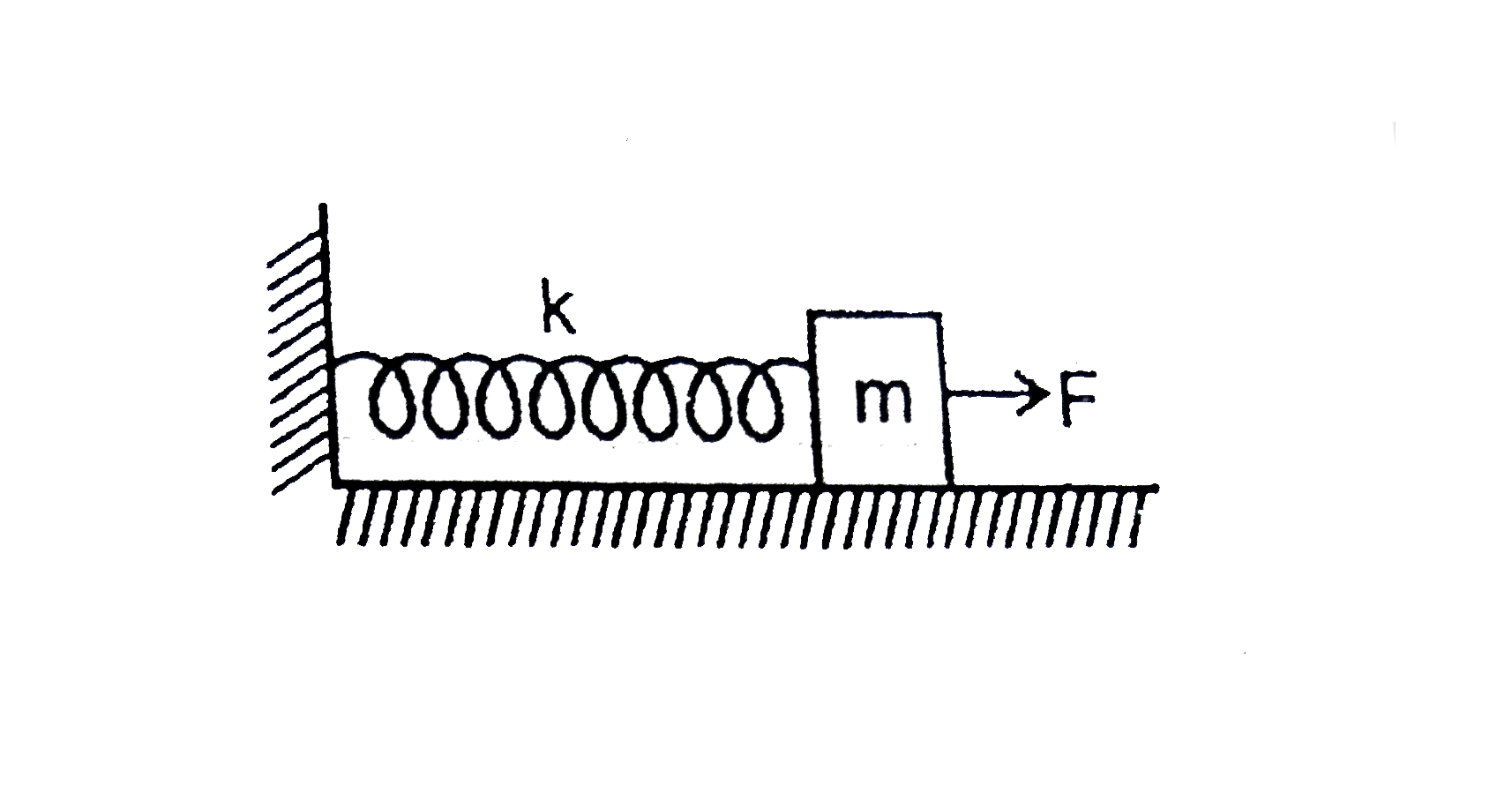A block of mass 2.0 kg is given an initial speed along the floor towards a spring as shown. The coefficient of kinetic friction between the floor and the block is 0.4 and force constant of the spring is 5.6×103 N/m. The block compresses the spring by 10cm before it stops for a moment. What is the initial speed (m/s) of the block?
 Solution in Gujrati
Solution in Gujrati
3.6 m/s
4.7 m/s
4.0 m/s
6.0 m/s
The correct Answer is:A
Step by step video & image solution for A block of mass 2.0 kg is given an initial speed along the floor towards a spring as shown. The coefficient of kinetic friction between the floor and the block is 0.4 and force constant of the spring is 5.6xx10^(3) N/m. The block compresses the spring by 10cm before it stops for a moment. What is the initial speed (m/s) of the block? by Physics experts to help you in doubts & scoring excellent marks in Class 12 exams.
Updated on:21/07/2023Topper's Solved these Questions
- TEST PAPERBOOK - ALLEN CHAPTER - TEST PAPEREXERCISE - PHYSICS
4 Videos
- TEST PAPERBOOK - ALLEN CHAPTER - TEST PAPEREXERCISE - PHYSICS
4 Videos
- SIMPLE HARMONIC MOTIONBOOK - ALLEN CHAPTER - SIMPLE HARMONIC MOTIONEXERCISE - Example
1 Videos
- TEST PAPER 1BOOK - ALLEN CHAPTER - TEST PAPER 1EXERCISE - PHYSICS
11 Videos
Similar Questions
Choose the correct statement:
View SolutionChoose the correct statement:
View SolutionA rod with rectangular cross section oscillates about a horizontal axis passing through one of its ends and it behaves like a seconds pendulum, its length will be
View SolutionWhy are electric field lines perpendicular at a point on an equipotential surface of a conductor ?
View SolutionA 2kg block slides on a horizontal floor with the a speed of 4m//s it strikes a uncompressed spring , and compresses it till the block is motionless . The kinetic friction force is compresses is 15 N and spring constant is 10000 N//m . The spring by
View SolutionFigure shows, a 3.5kg block accelerated by a compressed spring whose spring constant is 740N/m. After, leaving the spring at the spring' s relaxed length, the block travels over a horizontal surfce, with a coefficient of kinetic friction of 0.25, for a distance of 7.8m before stopping. (g=9.8m/s2).
 .
.
(a) What is the increase in the thermal energy of the block-floor system ?
(b) What is the maximum kinetic energy of the block ?
(c) Through that distance is the spring compressed before the block begins to move ?
View SolutionA small block of ice with mass 0.120kg is placed against a horizontal compressed spring mounted on a horizonta table top that is 1.90m above the floor. The spring has a force constant k=2300M/m and is initially compressed 0.045m. The mass of the spring is negligible. The spring is releaded and the block slock slides along the table, goes off the edge and travels to the floor. If there is negligible friction between the ice and the table, what is the speed of the block of ice when it reaches the floor. (g=9.8m/s2)
 .
.
View SolutionA block of mass m is moving with a speed v on a horizontal rough surface and collides with a horizontal mounted spring of spring constant k as shown in the figure .The coefficient of friction between the block and the floor is μ The maximum compression of the spring is

View SolutionA block of mass m=2kg is connected to a a spring of force constant k=50N/m. Initially the block is at rest and tlhe spring has natural length. A constant force F=60N is applied horizontally towards, the maximum speed of the block (in m/s) will be (negelect friction).

View Solution1 kg block collides with a horizontal massless spring of force constant 2N/m. The block compresses the spring by 4m. If the coefficient of kinetic friction between the block and the· surface is 0.25, what was the speed of the block at the instant of collision? (take g=10m/s2)

View SolutionA spring-block system is resting on a frictionless floor as shown in the figure. The spring constant is 2.0 N m^(–1) and the mass of the block is 2.0 kg. Ignore the mass of the spring. Initially the spring is in an unstretched condition. Another block of mass 1.0 kg moving with a speed of 2.0 m s^(–1) collides elastically with the first block. The collision is such that the 2.0 kg block does not hit the wall. The distance, in metres, between the two blocks when the spring returns to its unstretched position for the first time after the collision is _________.
View SolutionA block of mass m is initially moving to the right on a horizontal frictionless surface at a speed v. It then compresses a spring of spring constant k. At the instant when the kinetic energy of the block is equal to the potential energy of the spring, the spring is compressed a distance of :
View SolutionA 2 kg block slides on a horizontal floor with a speed of 4 m/s. It strikes an uncompressed spring, and compresses it till the block is motionless. The kinetic friction force is 15 N and spring constant is 10000 N/m. The spring is compressed by (in cm):
View Solution15 किग्रा का एक ब्लॉक 0.6 मी/से की चाल से एक घर्षणहीन मेज के क्षैतिज तल पर फिसलता है। यह ब्लॉक एक स्प्रिंग को संकुचित कर एक क्षण के लिए विरामावस्था में आ जाता है । स्प्रिंग में उत्पन्न अधिकतम संकुचन ज्ञात कीजिये। ( स्प्रिंग नियतांक k=1500 न्यूटन/ मी )
View SolutionA 2 kg block slides on a horizontal floor with a speed of 4 m/s. It strikes an uncompressed spring, and compresses it till the block is motionless. The kinetic friction force is 15 N and spring constant is 10,000 N/m. The spring compresses by :
View SolutionBlock of mass m is pushed towards a horizontal spring as shown in figure , with initial speed u .

Spring constant of the spring is K and floor is smooth . Calculate maximum possible compression of the spring .
View Solution
